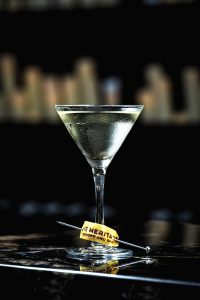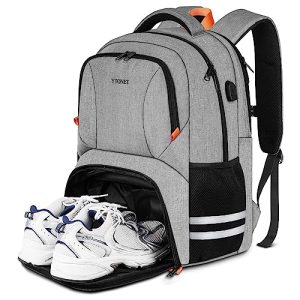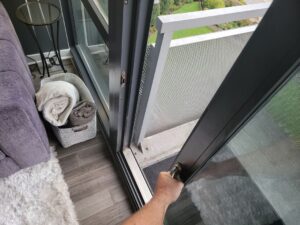Contents
Are you a proud fish pond owner looking for the best automatic feeder for your aquatic friends? Look no further! In this guide, we will help you navigate the world of automatic feeders and find the perfect one for your fish pond. Say goodbye to manual feedings and hello to convenience and peace of mind. With our expert tips and recommendations, you’ll be able to choose a feeder that meets your specific needs and ensures your fish are well-fed, even when you’re away. Get ready to say hello to hassle-free feeding and happy, healthy fish!
Factors to Consider
When choosing the best automatic feeder for your fish pond, there are several factors you need to consider. These factors will ensure that you make an informed decision and select a feeder that suits your specific needs.
Size of the Fish Pond
The size of your fish pond is an important factor to consider when selecting an automatic feeder. Larger ponds will require feeders with a higher capacity and a longer range to ensure that all the fish are properly fed. On the other hand, if you have a smaller pond, a feeder with a smaller capacity may be sufficient. It’s important to accurately measure the size of your fish pond to determine the appropriate feeder size.
Feeding Schedule
Another factor to consider is the feeding schedule of your fish. Different fish species have different feeding requirements, and it’s essential to choose a feeder that can accommodate these needs. Some feeders offer programmable scheduling options, allowing you to set specific feeding times throughout the day. This feature is particularly useful if you have a busy lifestyle and cannot always be available to manually feed your fish.
Types of Fish in the Pond
The types of fish you have in your pond will also influence the choice of an automatic feeder. Some fish are more aggressive feeders and may require a feeder that can handle their feeding behavior. Additionally, certain fish may have specific dietary needs, such as larger pellets or live food. Ensure that the feeder you choose can dispense the appropriate type and size of food for your fish.
Feeder Capacity
The feeder capacity refers to the amount of food the feeder can hold at one time. This is an important consideration, especially if you have a large number of fish in your pond. A feeder with a larger capacity will require less frequent refilling, providing convenience and less maintenance. However, if you have a smaller pond or fewer fish, a feeder with a smaller capacity may suffice.
Weather Resistance
Considering the weather conditions in your area is crucial when selecting an automatic feeder. The feeder will be exposed to the elements, and it’s important to choose one that is weather-resistant. Look for feeders that are made from durable materials and have proper sealing to prevent water damage. This will ensure that your feeder can withstand rain, snow, and other harsh weather conditions, prolonging its lifespan.
Types of Automatic Feeders
Now that you have considered the factors that influence your choice, it’s important to understand the different types of automatic feeders available for fish ponds. Each type has its own unique features and advantages.
Gravity Feeders
Gravity feeders are simple devices that rely on the natural pull of gravity to dispense the fish food. They consist of a container that holds the food and a small opening at the bottom, allowing the food to fall into the pond. These feeders are easy to install and require minimal maintenance. However, they do not offer programmable scheduling options and may not be suitable for ponds with specific feeding requirements.
Programmable Electronic Feeders
Programmable electronic feeders are more advanced and feature-rich than gravity feeders. These feeders allow you to set specific feeding times and portion sizes for your fish. They often come with digital controls and an LCD display, making it easy to program and adjust the feeding schedule. Programmable electronic feeders are suitable for ponds with various fish species and specific feeding needs.
Vibratory Feeders
Vibratory feeders use vibration to dispense the fish food into the pond. These feeders are equipped with a small motor that generates vibrations, causing the food to fall into the pond. Vibratory feeders are suitable for ponds with fish that prefer live or frozen food, as the vibration simulates the movement of live prey. However, they may not be ideal for ponds with larger pellet-sized food.
Rotational Feeders
Rotational feeders are another type of automatic feeder that rotates a container containing fish food over the pond, dispensing it evenly. These feeders are best suited for ponds with multiple fish and can cover larger areas. The rotating mechanism ensures that all fish have access to the food, and the design prevents food from being wasted or accumulating in one area of the pond.
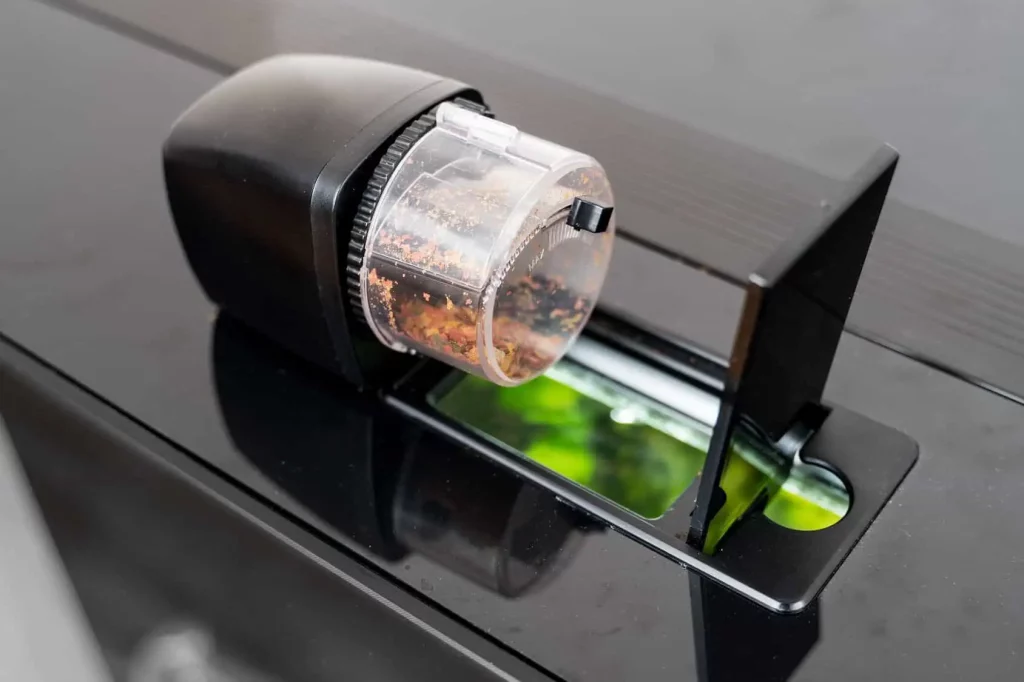
Features to Look For
Once you have determined the type of automatic feeder that best suits your fish pond, it’s important to consider the specific features of the feeder. These features will enhance your overall experience and ensure that the feeder meets your expectations.
Ease of Installation
Look for feeders that are easy to install and set up. Choose feeders that come with clear instructions and require minimal tools or additional equipment. This will save you time and frustration during the installation process.
Feeder Durability
Durability is a key factor to consider, as your feeder will be exposed to the elements. Look for feeders made from high-quality materials that can withstand the test of time. Materials such as weather-resistant plastics or stainless steel are ideal for outdoor use.
Ease of Maintenance
Consider the ease of maintenance when selecting a feeder. Look for feeders with removable parts that can be easily cleaned. Feeders that have a large opening for refilling are also convenient, as they minimize spillage and make the process quicker.
Battery Life
For electronic feeders, consider the battery life. Look for feeders with long battery life to avoid frequent replacements or recharging. Some feeders also come with low-battery indicators, which can be useful in ensuring that your feeder is always operational.
Adjustable Feeding Amount
Some feeders offer the option to adjust the feeding amount. This feature is beneficial if you have fish with different dietary requirements or if you need to control the amount of food being dispensed. Look for feeders that allow you to easily adjust and fine-tune the feeding amount.
Feed Dispensing Mechanism
Pay attention to the feed dispensing mechanism of the feeder. Ensure that it is reliable and does not clog easily. Some feeders have mechanisms that prevent food from falling out during windy conditions, reducing wastage and mess.
Control Options
Consider the control options available for the feeder. Some feeders offer remote control capabilities, allowing you to adjust the feeding schedule or dispense food manually from a distance. This feature can be particularly useful if you are away from home but still want to ensure that your fish are fed.
Budget Considerations
When it comes to determining the budget for your automatic fish pond feeder, there are a few factors to consider.
Price Range
The price range for automatic fish pond feeders can vary significantly depending on the type, features, and brand. Gravity feeders tend to be more affordable, while programmable electronic feeders and rotational feeders may be on the higher end of the price spectrum. Consider your budget and look for feeders that offer the desired features within your price range.
Long-Term Costs
In addition to the initial purchase price, it’s important to consider the long-term costs associated with the automatic feeder. This includes the cost of batteries or power consumption for electronic feeders, as well as any maintenance or replacement parts that may be required. Consider these long-term costs to ensure that the feeder remains within your budget in the long run.
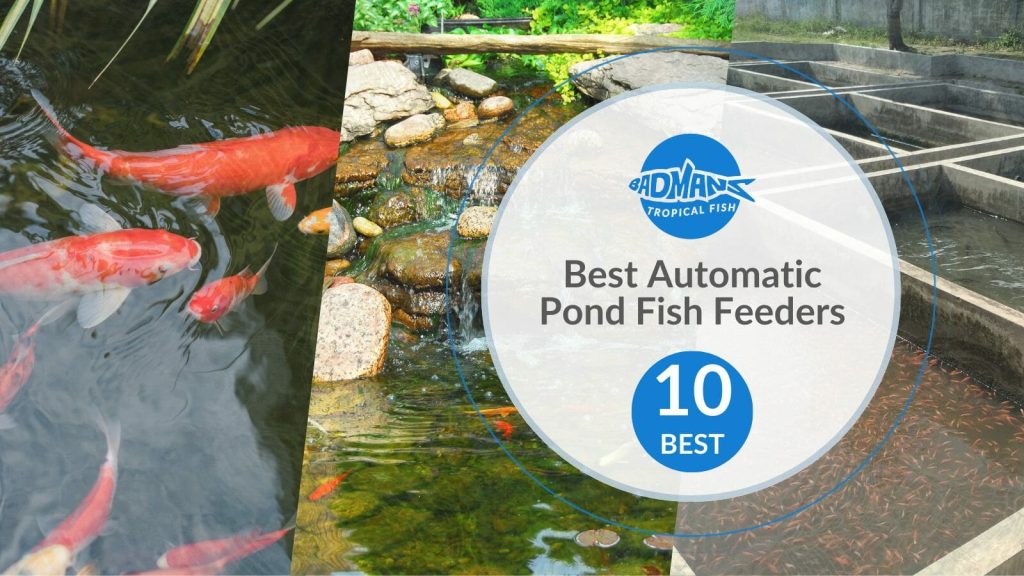
Maintenance and Cleaning
Proper maintenance and cleaning of your automatic feeder are essential for its longevity and effectiveness. Consider the following factors when it comes to maintaining and cleaning your feeder.
Cleaning Frequency
The cleaning frequency of your automatic feeder will depend on the type of food used and the environmental conditions. Some feeders may require more frequent cleaning to prevent food residue buildup or clogging. Consider your fish’s feeding habits and the feeder’s design to determine the optimal cleaning frequency.
Compatibility with Cleaning Products
Ensure that the feeder is compatible with the cleaning products you plan to use. Some chemicals or cleaning agents may damage certain feeder materials or components. Read the manufacturer’s instructions or consult customer support to determine the best cleaning methods and products for your specific feeder.
Replacement Parts Availability
Check if replacement parts for the feeder are readily available. Over time, certain parts of the feeder may wear out or become damaged. Having access to replacement parts will ensure that your feeder can be repaired if necessary, saving you the cost of purchasing a new one.
Tips for Installation and Setup
Installing and setting up your automatic feeder correctly is crucial to ensure its proper functioning. Consider the following tips to make the installation and setup process smooth and hassle-free.
Choosing the Right Location
Select a suitable location for your feeder, taking into account factors such as accessibility, protection from extreme weather conditions, and proximity to the pond. Ensure that the feeder is easily reachable for refilling and maintenance, while also being secure and stable.
Securing the Feeder
To prevent the feeder from being knocked over or tampered with, secure it to a stable surface or use anchor stakes if provided. This will ensure that the feeder remains in place and that the food is dispensed accurately into the pond.
Testing and Adjusting the Feeding Amount
After installing the feeder, test it to ensure that the feeding amount and mechanism are functioning correctly. Adjust the feeding amount as necessary, considering the size and appetite of your fish. Observe the fish during feeding to ensure that they are receiving the appropriate amount of food.
Programming the Feeding Schedule
If you have a programmable electronic feeder, take the time to program the feeding schedule according to your fish’s needs. Consider factors such as the time of day, the number of feedings per day, and the duration between feedings. Follow the instructions provided by the manufacturer to set up a feeding schedule that suits your specific requirements.
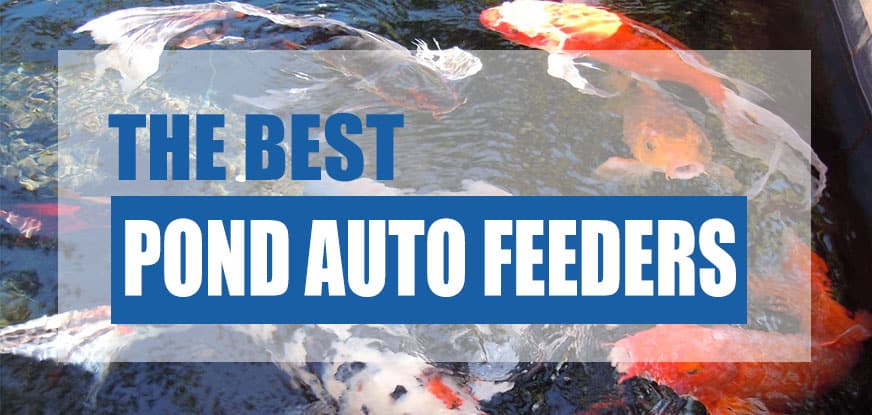
Common Issues and Troubleshooting
While automatic feeders are designed to be convenient and reliable, occasional issues may arise. Here are some common issues you may encounter and tips for troubleshooting them.
Feeder Malfunction
If your feeder stops working or malfunctions, check the battery or power source. Replace or recharge the battery if necessary. Ensure that all connections are secure and that the feeder is properly programmed or adjusted. If the issue persists, consult the manufacturer’s troubleshooting guide or contact customer support for assistance.
Accumulation of Feed
If you notice an accumulation of feed in the pond or around the feeder, adjust the feeding amount to prevent overfeeding. Be mindful of the amount of food dispensed and the feeding schedule. Remove any excess or uneaten food to maintain the cleanliness of the pond and prevent water quality issues.
Overfeeding
Overfeeding can lead to poor water quality and health issues for your fish. If you observe signs of overfeeding, such as excessive waste or algae growth, reduce the feeding amount or frequency. Monitor your fish’s behavior and adjust the feeding schedule accordingly. Remember, it’s better to slightly underfeed than to overfeed.
Battery Drain
If you find that the battery is draining quickly, ensure that the feeder is not dispensing food continuously or experiencing any malfunctions. Adjust the feeding schedule or consider replacing the battery with a higher capacity one. If the issue persists, contact the manufacturer for guidance.
Clogging
Clogging can occur if the feeder dispenses moist or clumpy food. Ensure that the food is dry and free of clumps before filling the feeder. Some feeders have mechanisms to prevent clogging, such as anti-jamming systems or adjustable dispensing openings. Clean the feeder regularly to prevent any residue buildup that may lead to clogging.
Reviews and Recommendations
To make an informed decision, it’s always helpful to read reviews and recommendations from other fish pond owners. Consider the following sources to find reliable and top-rated automatic feeders:
Most Reliable Brands
Research reputable brands that are known for manufacturing high-quality and reliable feeders. Look for customer reviews and ratings to gauge the satisfaction and experiences of other pond owners. Some well-regarded brands in the automatic feeder market include Fish Mate, EHEIM, and P7000.
Top-Rated Automatic Feeders
Review websites and forums dedicated to fish pond enthusiasts often feature comprehensive reviews and rankings of automatic feeders. Explore these resources to find the top-rated feeders based on factors such as performance, durability, and customer satisfaction. Take note of the specific features and user experiences mentioned in these reviews to help guide your decision-making process.
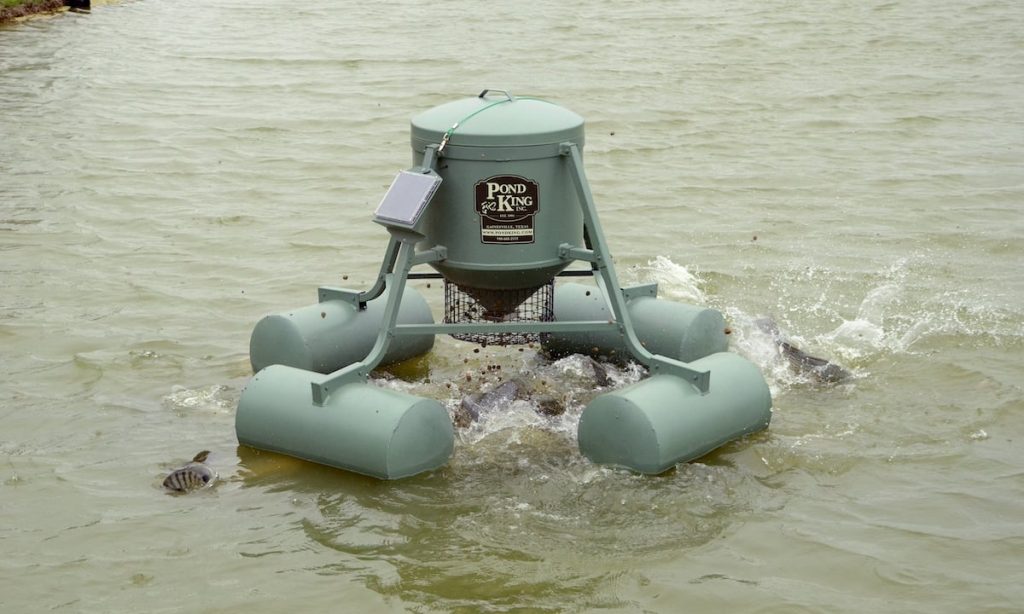
Conclusion
Choosing the best automatic feeder for your fish pond involves considering several factors, such as the size of the pond, feeding schedule, types of fish, feeder capacity, and weather resistance. Understanding the different types of feeders and their features will help you make an informed decision. Take into account your budget and long-term costs, as well as factors like maintenance and cleaning, installation and setup tips, troubleshooting ideas, and reviews from other pond owners. By carefully considering all these factors, you can select an automatic feeder that best suits your needs and provides a convenient and efficient way to feed your fish while ensuring their health and well-being.




